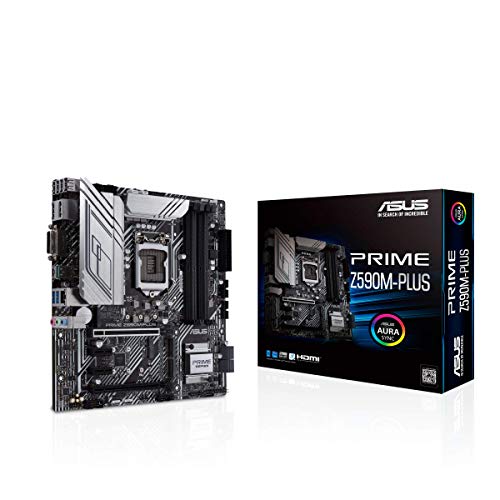Best Z590 Motherboard: Complete Reviews With Comparisons

Recently, Intel released its lineup of 11th Generation Rocket Lake processors.
To get the most out of any of them, you will need the best Z590 motherboards.
The Z590 chipset is relatively new, having only been released this first quarter.
You can still use the older Z490 motherboards for the new Rocket Lake processors if you need a more affordable option.
However, you will need the Z590 chipset for maximum optimization of any Rocket Lake.
We’ve come up with five outstanding Z590 boards that can work well with any 11th Gen Rocket Lake CPU.
Comparison Chart
Z590 Motherboard Reviews
1. Asus ROG Strix Z590-E Gaming Wi-Fi
The Asus ROG Strix Z590-E Wi-Fi is a gaming motherboard with a robust 16-stage power delivery system.
While it sits in the middle of the Asus product line, you will find it at the top tier of gaming boards.
It is an AI 2.0 motherboard, which means it can maximize the performance of any 11th Gen Intel Core processor.
ALSO READ: Best Motherboard for i5 8400
Review
Asus has done a superb job on the aesthetics of the ROG Strix Z590-E Gaming Wi-Fi.
As such, you’ll find that it is one of the most appealing Z590 motherboards available in the market.
Remarkably, it comes with a very comprehensive feature set, even if it is somewhat cheaper than many similarly equipped models.
It overclocks pretty well, too, but you might have to adjust the voltage and select the correct multiplier manually to compensate.
Furthermore, its high-end specs, exceptional cooling solutions, and high-performance gaming capabilities increase its overall value.
- High-End Specifications
The Z590-E allows up to 128GB of system RAM with its four DDR4 DIMM slots that support Intel XMP and OptiMem III.
Memory overclocking speeds can go as high as 5333MHz using non-ECC memory modules.
With an 11th Generation Intel Core processor, the base memory clocks can run up to 3200MHz.
For expansion, you will find two PCIe 4.0 x16 slots and one PCIe 3.0 x16 slot.
You can use NVIDIA 2-Way SLI multi-graphics components on the PCIe 4.0 sockets.
Unless an attached device runs at the default x2 mode, populating the PCIe 3.0 slot disables SATA5 and SATA6 for storage devices.
You’ll be glad to know that you can have more options for storage with the Z590-E than most of the other alternatives.
It sports four M.2 slots aside from the six SATA 6Gbps ports that support RAID 0, 1, 5, and 10.
Even then, using a SATA device on the fourth M.2 slot disables the SATA6 port.
The two M.2 slots on the top support PCIe 4.0 devices if you pair the board with an 11th Gen processor.
- Full Gaming Connectivity and Immersion
The Z590-E offers full gaming connectivity with its rear panel I/O.
It boasts dual 2.5Gb Ethernet ports and a Wi-Fi 6E AX210 module, which also incorporates Bluetooth 5.2.
Additionally, it carries a SupremeFX 8-Channel HD Audio component with an optical S/PDIF out port.
With this, your PC gets highly immersive for gaming not only because of the high-end audio but also with its lighting effects.
The heatsinks have built-in Aura Sync LEDs that work flawlessly well with two RGB headers and two addressable LED headers.
- Comprehensive Cooling
The Z590-E motherboard ensures that you never have to worry about upscaling the performance of your rig.
Asus packed it full of cooling components, such as integrated I/O and MOS heatsinks, an L-shaped heat pipe, and M.2 heatsinks.
Aside from a water pump header, the board has a total of seven fan headers.
PROS
CONS
2. Gigabyte Z590 Aorus Elite AX
For those looking for a budget-friendly approach to having a Rocket Lake system, the Gigabyte Z590 Aorus Elite AX is a viable option.
It is a feature-packed Z590 ATX motherboard with a solid 12-phase power delivery solution.
The AX sits in the middle of the Z590 Aorus Elite product line, and it offers all the features you need with minimal compromise.
Review
This board is a mid-range Z590 chipset motherboard with a silver and black color scheme.
It has LED lighting built into the chipset heatsink behind the Aorus logo.
Moreover, you’ll find plenty of fan inputs and RGB headers for all of your cooling and colorful lighting requirements.
The board looks and feels great, but the Gigabyte RGB Fusion software is still a bit finicky.
- Up-To-Date Components
The four DDR4 memory slots have a combined total capacity of 128GB.
With some of the 11th Gen Intel Core processors, you can squeeze up to 5400MHz of overclocked RAM speeds.
Stock memory speeds also sit around 3200MHz.
The Aorus Elite AX only has two full-length PCIe slots, and only one of them can support PCIe 4.0 devices.
The third expansion slot is a PCIe 3.0 x1 socket.
The full-length expansion slots support AMD Quad-GPU CrossFire or 2-Way AMD CrossFire multi-graphics technologies.
For storage, the Aorus Elite AX has six SATA 6Gbps ports with support for RAID 0, 1, 5, and 10.
Additionally, it has two M.2 sockets, one PCIe 4.0 x4, and a second one capable of holding a SATA or PCIe 3.0 device.
- Entry-Level Gaming for Rocket Lake
The affordability of the Aorus Elite AX makes it an excellent entry-level component for those looking to have quality gaming experiences.
It uses a Realtek ALC1220-VB codec to provide high-definition audio.
In addition to its five audio jacks, it has an optical S/PDIF Out port.
- Quality Wireless Communications
The Aorus Elite AX boasts the latest Wi-Fi 6 technology and Bluetooth version 5.1.
Aside from the Wi-Fi 6 module, everything is similar to the non-AX Aorus Elite.
Its LAN adapter is a Realtek 2.5GbE chip.
Consequently, both wired and wireless adapters are pretty much sufficient for most gaming connections.
PROS
CONS
3. Asus ROG Maximus XIII Hero
The Asus ROG Maximus XIII Hero is one of the pricier Z590 motherboards.
Its extended feature set and high-end appearance cater to many prosumers and gaming enthusiasts.
It is a well-built motherboard with a DIY-friendly design that offers unmatched personalization.
ProCool II power connectors, MicroFine alloy chokes, 10K Japanese-made capacitors, and 16 power stages provide the best power solution.
Plus, the onboard controls, connectors, and sockets make the initial setup an enjoyable experience.
Review
The Asus ROG Maximus XIII Hero is a well-rounded, feature-packed, upper-tier Z590 motherboard.
It offers spot-on performance using its highly capable 90-ampere power delivery system, and it easily handles memory overclocking.
The only disadvantage of the Maximus XIII Hero is its steep price.
Many competing motherboards offer very similar overclocking results at a much lower price point.
- High-Performance Components
With its four DDR4 dual-channel memory slots, this board’s maximum memory size is 128GB.
It has two PCIe 4.0 x16 primary expansion sockets and one extra PCIe 3.0 x16.
You can use the first two x16 sockets for an NVIDIA 2-Way SLI multi-graphics setup.
Additionally, the board has a single PCIe 3.0 x1 slot.
For storage, the Maximus XIII Hero has six SATA 6Gbps ports that support RAID 0, 1, 5, and 10 arrays.
Furthermore, like the ROG Strix Z590-E Wi-Fi, it has four M.2 slots.
The first two M.2 slots run PCIe 4.0 x4 storage devices, while the other two can run PCIe 3.0 x4 devices.
The fourth M.2 slot also works with SATA storage drives.
- Unmatched Personalization
As with most Asus ROG motherboards, the Maximus XIII Hero is compatible with the Asus-exclusive Aura Sync app.
You can customize the board’s RGB lighting using its single RGB header and three addressable Gen2 headers.
What’s more, even built-in RGB lights on third-party cooling fans work well with the LED connectors.
- Best Gaming Experience
The latest PCIe 4.0, quad M.2, Thunderbolt 4, and Gen2x2 USB 3.2 lets you have the fastest and most reliable gaming connections.
In addition, the onboard Wi-Fi 6E module and dual Intel 2.5Gb Ethernet with Asus LANGuard are more than enough to keep online games running smoothly.
Another component that provides the best gaming immersion is the board’s industry-leading audio.
The Maximus XIII Hero has a ROG SupremeFX ALC4082 module with ESS ES9018Q2C DAC for high-fidelity audio.
- Intelligent Control
This pricey motherboard has all the components for an optimized thermal design.
Its enlarged VRM heatsinks, integrated aluminum I/O cover, highly conductive thermal pad, and quad M.2 heatsinks provide the best heat dissipation across the board.
Equally important are its embedded backplates and ROG Water-Cooling zone.
To put all of these to work, Asus provides exclusive firmware and software utilities that streamline the setup and improve the board’s performance.
These utilities include artificially intelligent overclocking, cooling, networking, and noise cancellation.
PROS
CONS
4. Asus Prime Z590M-Plus
While the first three options are enough for a standard-sized PC, nothing stops you from creating a small form factor PC.
The Asus Prime Z590M-Plus is a micro ATX motherboard capable of handling the latest Rocket Lake CPUs.
The standard design of the Prime Series on the Z590M-Plus includes light-gray heatsinks and shields on a primarily black motherboard.
Additionally, the board features white stripes extending diagonally across the board.
Unfortunately, the board doesn’t have built-in RGB lights.
Review
Asus strives to give the Prime Z590M-Plus the most critical functions while incorporating a basic and sturdy design.
It is the perfect solution for a cheap high-end PC with an 11th Gen Intel Core CPU.
The board features comprehensive controls for tuning your whole system, allowing for maximum productivity and performance tweaks.
One essential component is its configurable cooling controls via the Fan Xpert 4 software.
Like most Z590 motherboards, the Z590M-Plus’ downside is its incapability to maximize its potential without an 11th Gen CPU.
Another downside is the missing Wi-Fi module.
Because of this, you will have to purchase a Wi-Fi adapter separately and install it on one of the expansion slots.
- Maximized ATX Specs
Unlike mini ITX form factor boards, the micro ATX Z590M-Plus has four DDR4 DIMM slots capable of holding up to 128GB of system RAM.
Impressively enough, its memory overclocking speeds can go as high as 5133MHz.
The Z590M-Plus has one PCIe 4.0 x16 slot, one PCIe 3.0 x16 slot, and two PCIe 3.0 x1 sockets for expansion.
For storage, the board has five SATA 6Gbps ports and three M.2 slots.
Using a SATA device on the second M.2 slot disables the SATA6G_1 connector.
- Next-Generation Connectivity
The Z590M-Plus is highly capable of providing the latest connectivity components.
In addition to the PCIe 4.0 slot, it comes with an Intel 1Gb Ethernet, Thunderbolt4 header support, and a USB 3.2 Gen2x2 Type-C.
Since Asus built it to handle the additional cores and increased bandwidth of 11th Gen Intel Core processors, it can boost daily productivity.
- Enhanced Power Solution
The power solution on the Z590M-Plus is a nine-stage DrMOS power delivery system with an eight-pin ProCool power connector.
It also has durable alloy chokes and capacitors that can deliver a stable, continuous power supply.
Additionally, the large VRM heatsinks, PCH heatsink, and hybrid fan headers complement the reliable power delivery system.
PROS
CONS
5. MSI MEG Z590I Unify
If the micro ATX Asus Prime Z590M-Plus is still too big for your small PC, go for the MSI MEG Z590I Unify instead.
It has a mini ITX form factor that is much smaller than any micro ATX board.
The MEG Z590I Unify is a high-end motherboard featuring massive aluminum heatsinks and an all-black finish.
A rear I/O cover protects the connectors. Plus, it is also made of aluminum, making it an additional cooling solution.
Review
The MSI MEG Z590I Unify is among the best mini ITX motherboards for Rocket Lake CPUs.
However, it falls short on the quality of its front panel audio connector.
Another downside is the sandwiched M.2 slots, which may not be ideal for high-end solid-state drives with their own cooling system.
The last cumbersome component we found is the board’s TPM header.
It sits at a tight spot, which makes installation quite challenging.
Aside from these disadvantages, everything else on the board is excellent, so we recommend it to anyone who has the budget.
- Uncompromised Rocket Lake Build
The small form factor of this board permits a total memory capacity of 64GB using two DDR4 memory slots.
Maximum overclocking frequencies reach 5600MHz depending on the paired CPU.
Although it is a mini ITX motherboard with fewer slots, the MEG Z590I Unify offers the latest PCIe 4.0 capabilities.
It has a single PCIe 4.0 x16 socket for any of the latest and fastest graphics cards.
Furthermore, one M.2 slot allows a PCIe 4.0, PCIe 3.0, or SATA storage device.
The second M.2 slot only supports PCIe 3.0 connections.
In addition to the two M.2 slots, the MEG Z590I Unify has four SATA 6Gbps ports capable of supporting RAID 0, 1, 5, and 10.
- Unlimited Connectivity
The Z590I Unify sports the latest wireless connectivity solution using Wi-Fi 6E, which can deliver speeds up to 2400Mbps.
The board carries a 2.5Gb Ethernet LAN adapter for wired connections and pairs it with the LAN Manager app to provide lag-free online experiences.
MSI has been pretty generous with the ports on the rear I/O panel of this motherboard.
You will find two USB 2.0 ports, two USB 3.2 Gen1, and two USB 3.2 Gen2.
It also has dual Thunderbolt4 ports that can deliver 40Gbps speeds, 8K display support, and daisy-chaining.
Two Thunderbolt passthrough Mini DisplayPort Inputs sit right below the two Thunderbolt ports.
Additional display connectors include a regular-sized DisplayPort and an HDMI port.
Finally, the board has a built-in 2.5GbE LAN port and dual antennas for Wi-Fi and Bluetooth.
RELATED: Best Z490 Motherboard (Guide)
- Maximum Stability
The Z590I Unify is a ten-layer printed circuit board. Its multilayered design optimizes the stability of your system and keeps it cool.
Additionally, the copper circuits on the board are two ounces thick, enabling higher performance and a pretty long lifespan.
PROS
CONS
FINAL VERDICT
The Asus ROG Strix Z590-E Gaming Wi-Fi is undoubtedly the top Z590 motherboard among our options.
It is the most cost-effective choice, albeit being one of the more expensive ones.
However, if you want to save space with a tinier computer enclosure, go for the Asus Z590M-Plus instead.
The most important thing to remember, though, is that if you don’t pair these with a Rocket Lake CPU, you might not be able to get the most out of them.
All of these latest components are pretty expensive and may not be the most viable option.
You’ll be better off using an LGA1511 motherboard with the top-of-the-line 9th Gen Intel Core processors.














